Abstract
The poly(A)(+)-binding protein (PABP) is a highly conserved protein that binds to the poly(A)+ tail of mRNAs. PABP has been shown to regulate message stability and translational efficiency, yet the mechanisms remain unknown. To facilitate further dissection of the functions of this protein, we have expressed and purified Xenopus PABP using a baculovirus expression system. At 48 h after infection of insect Spodoptera frugiperda (Sf9) cells with recombinant virus, approx. 3% of cell protein was PABP. Purification of PABP was achieved by affinity chromatography on poly(A)(+)-Sepharose. The purified protein was indistinguishable from Xenopus PABP with respect to its immunoreactivity and electrophoretic mobility. Furthermore, the recombinant PABP was expressed and purified as a functional protein as indicated by its ability to bind to poly(A)(+)-Sepharose and its ability to enhance the translation of adenylated messages in vitro. By comparing protein extracts from various developmental stages of Xenopus embryos with known amounts of purified PABP, we determined the amount of PABP per embryo. This analysis suggested that there is less than one PABP molecule available per PABP-binding site at early stages of development, and only a slight excess of PABP at later stages.
Full text
PDF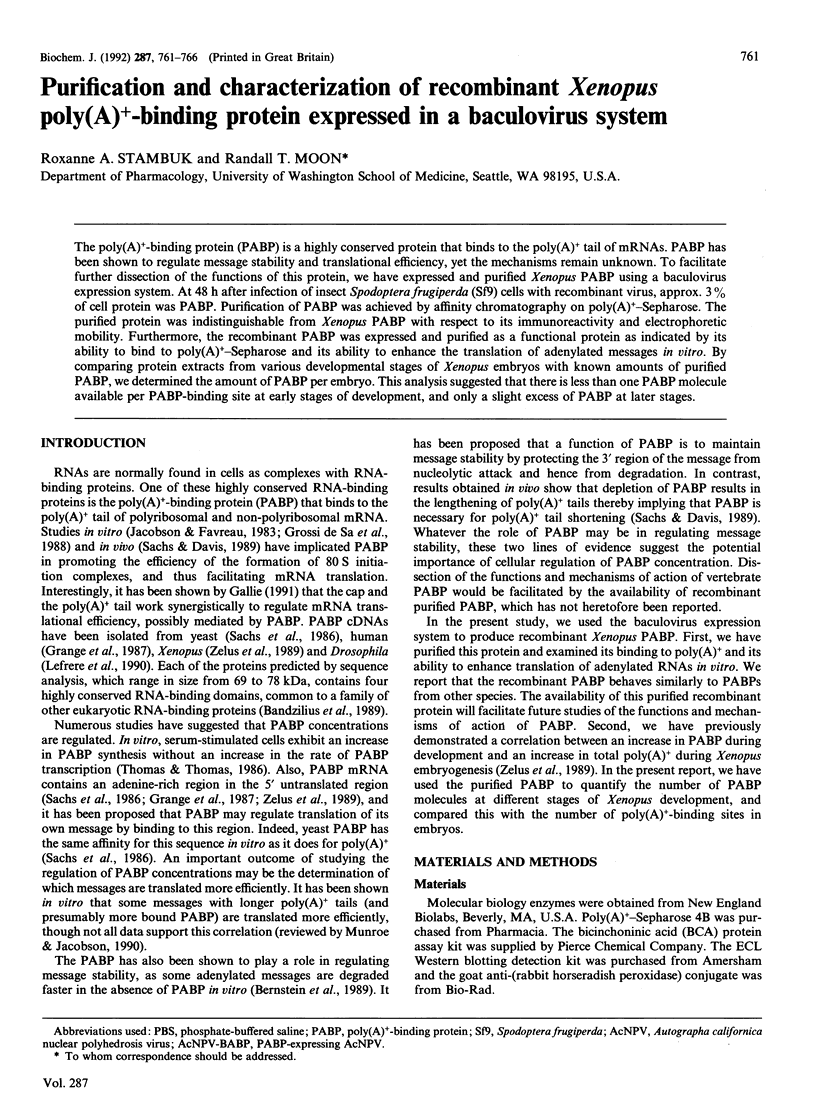
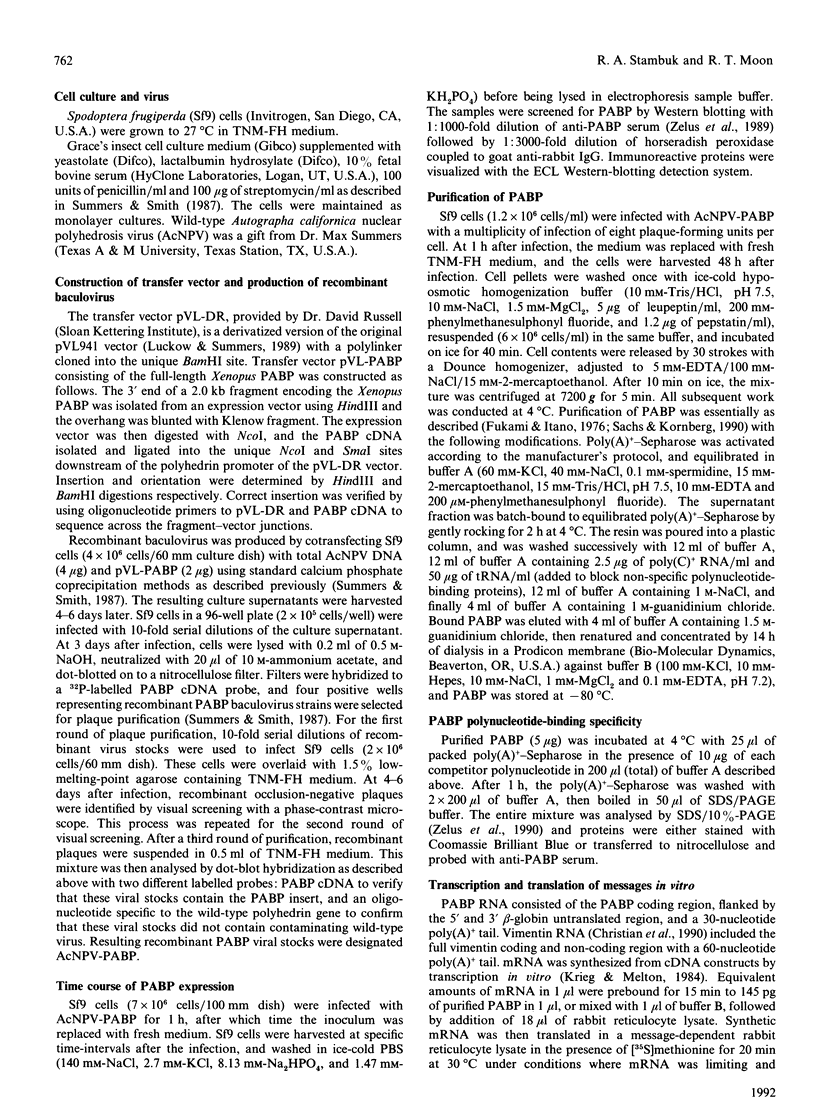
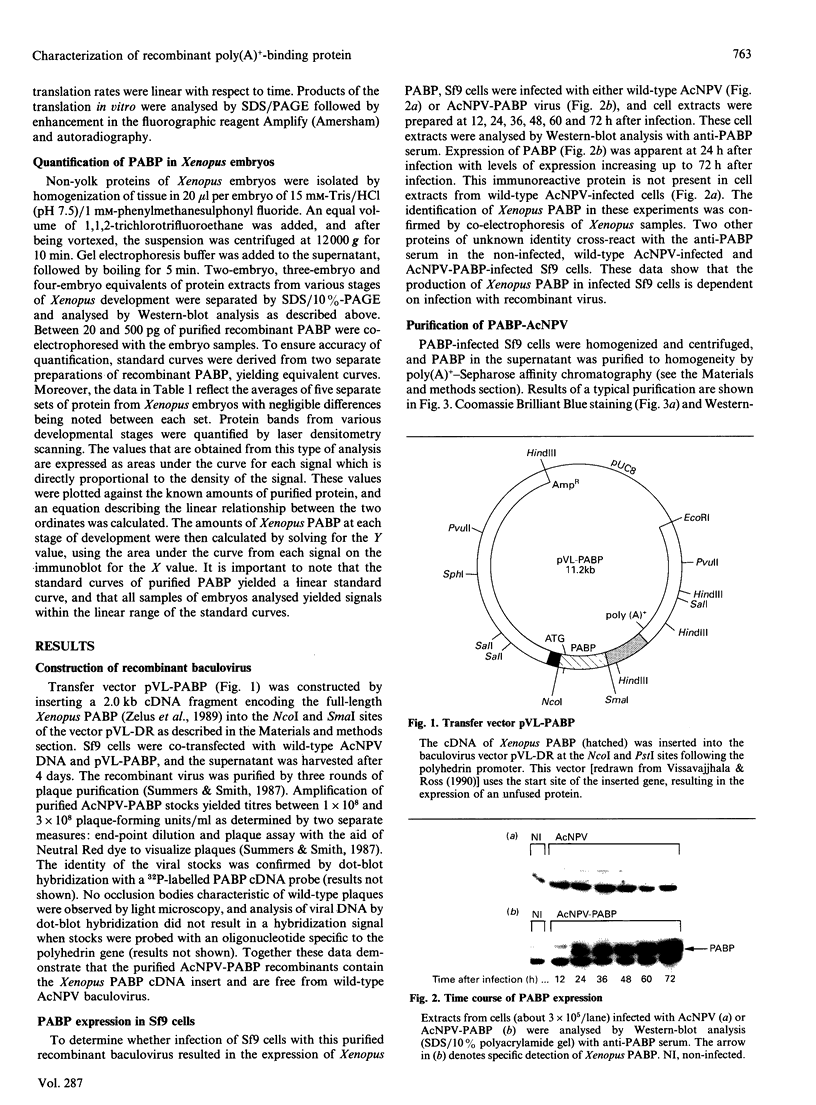
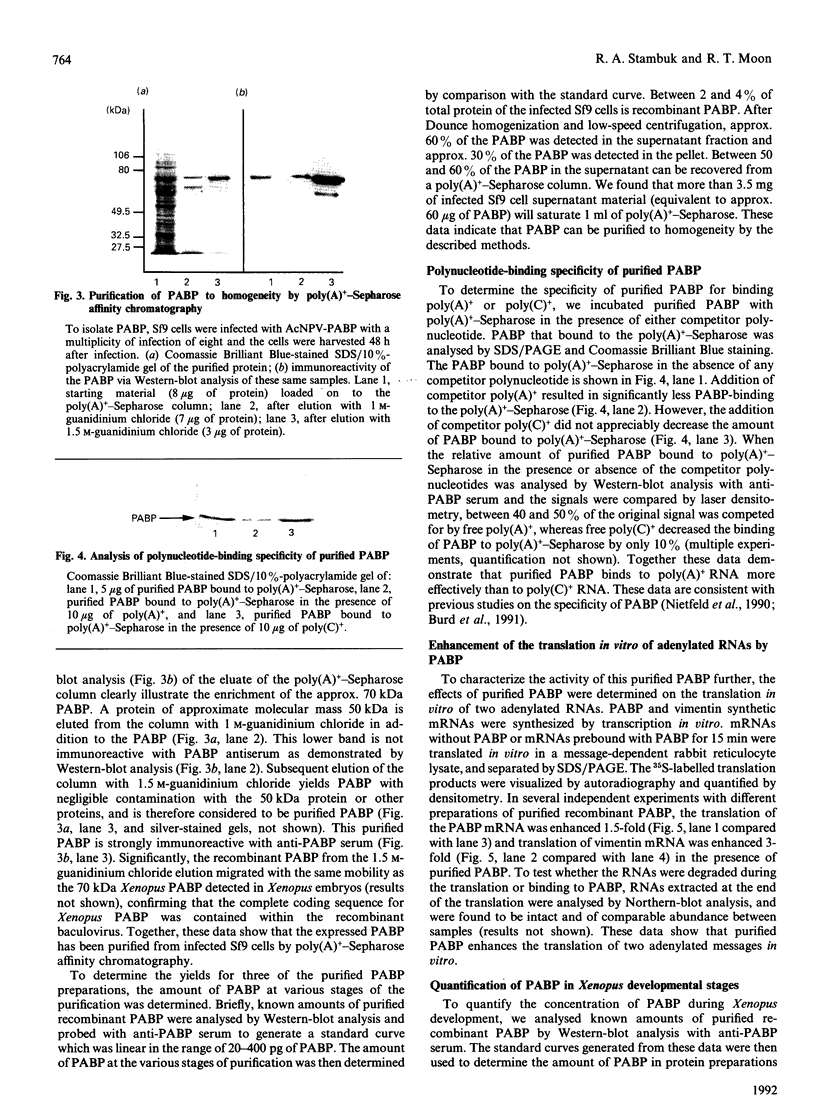
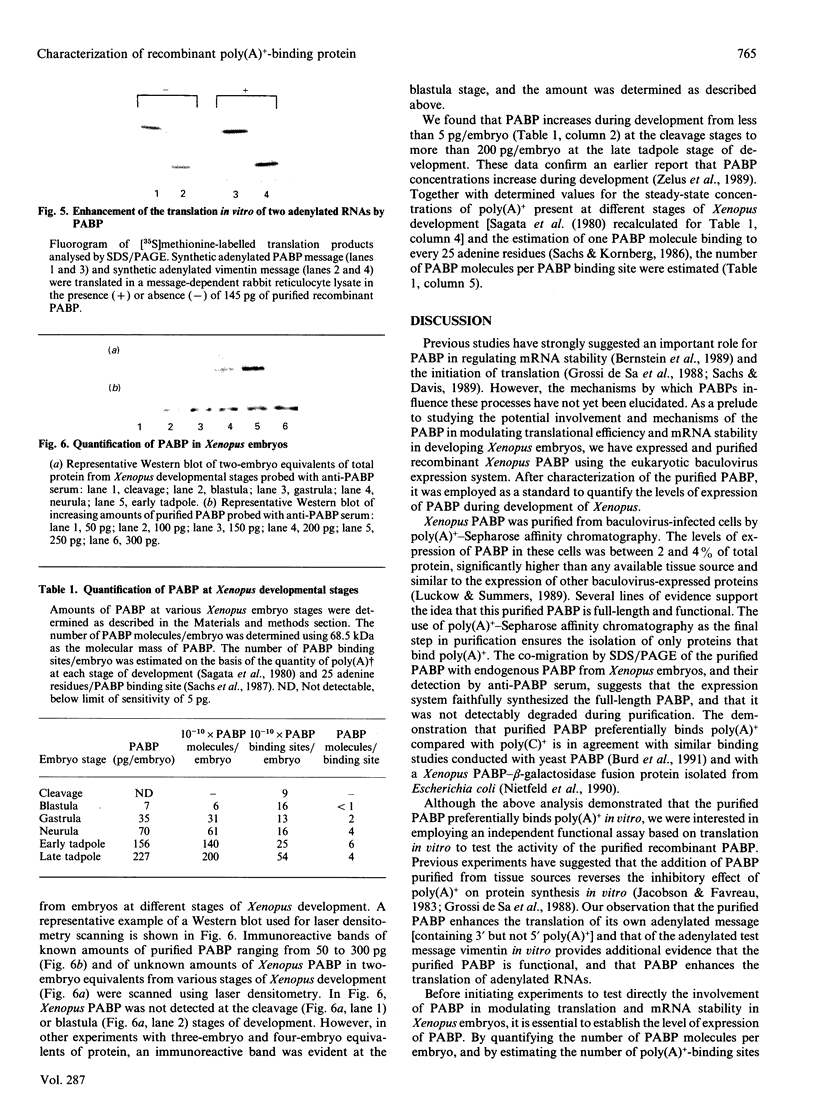
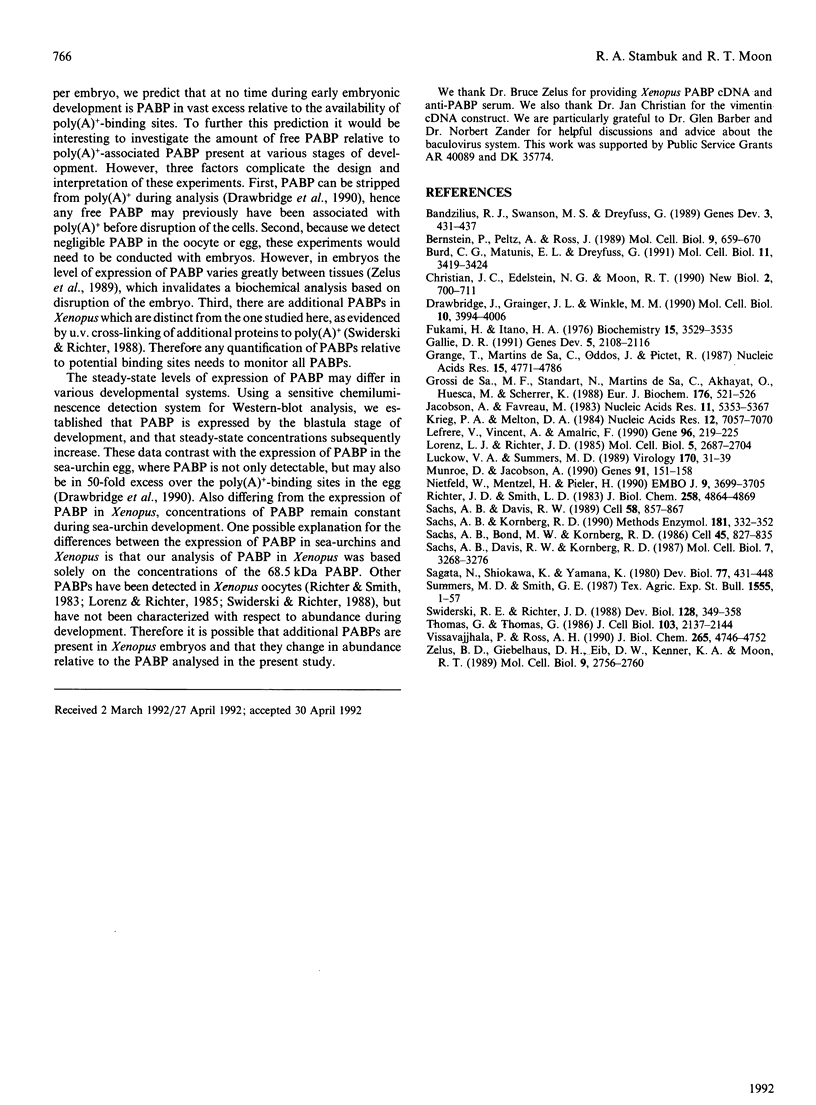
Images in this article
Selected References
These references are in PubMed. This may not be the complete list of references from this article.
- Bandziulis R. J., Swanson M. S., Dreyfuss G. RNA-binding proteins as developmental regulators. Genes Dev. 1989 Apr;3(4):431–437. doi: 10.1101/gad.3.4.431. [DOI] [PubMed] [Google Scholar]
- Bernstein P., Peltz S. W., Ross J. The poly(A)-poly(A)-binding protein complex is a major determinant of mRNA stability in vitro. Mol Cell Biol. 1989 Feb;9(2):659–670. doi: 10.1128/mcb.9.2.659. [DOI] [PMC free article] [PubMed] [Google Scholar]
- Burd C. G., Matunis E. L., Dreyfuss G. The multiple RNA-binding domains of the mRNA poly(A)-binding protein have different RNA-binding activities. Mol Cell Biol. 1991 Jul;11(7):3419–3424. doi: 10.1128/mcb.11.7.3419. [DOI] [PMC free article] [PubMed] [Google Scholar]
- Christian J. L., Edelstein N. G., Moon R. T. Overexpression of wild-type and dominant negative mutant vimentin subunits in developing Xenopus embryos. New Biol. 1990 Aug;2(8):700–711. [PubMed] [Google Scholar]
- Drawbridge J., Grainger J. L., Winkler M. M. Identification and characterization of the poly(A)-binding proteins from the sea urchin: a quantitative analysis. Mol Cell Biol. 1990 Aug;10(8):3994–4006. doi: 10.1128/mcb.10.8.3994. [DOI] [PMC free article] [PubMed] [Google Scholar]
- Fukami H., Itano H. A. In vitro translation of globin: effect of proteins purified by affinity chromatography on polyadenylate-Sepharose. Biochemistry. 1976 Aug 10;15(16):3529–3535. doi: 10.1021/bi00661a021. [DOI] [PubMed] [Google Scholar]
- Gallie D. R. The cap and poly(A) tail function synergistically to regulate mRNA translational efficiency. Genes Dev. 1991 Nov;5(11):2108–2116. doi: 10.1101/gad.5.11.2108. [DOI] [PubMed] [Google Scholar]
- Grange T., de Sa C. M., Oddos J., Pictet R. Human mRNA polyadenylate binding protein: evolutionary conservation of a nucleic acid binding motif. Nucleic Acids Res. 1987 Jun 25;15(12):4771–4787. doi: 10.1093/nar/15.12.4771. [DOI] [PMC free article] [PubMed] [Google Scholar]
- Grossi de Sa M. F., Standart N., Martins de Sa C., Akhayat O., Huesca M., Scherrer K. The poly(A)-binding protein facilitates in vitro translation of poly(A)-rich mRNA. Eur J Biochem. 1988 Oct 1;176(3):521–526. doi: 10.1111/j.1432-1033.1988.tb14309.x. [DOI] [PubMed] [Google Scholar]
- Krieg P. A., Melton D. A. Functional messenger RNAs are produced by SP6 in vitro transcription of cloned cDNAs. Nucleic Acids Res. 1984 Sep 25;12(18):7057–7070. doi: 10.1093/nar/12.18.7057. [DOI] [PMC free article] [PubMed] [Google Scholar]
- Lefrère V., Vincent A., Amalric F. Drosophila melanogaster poly(A)-binding protein: cDNA cloning reveals an unusually long 3'-untranslated region of the mRNA, also present in other eukaryotic species [corrected]. Gene. 1990 Dec 15;96(2):219–225. doi: 10.1016/0378-1119(90)90256-q. [DOI] [PubMed] [Google Scholar]
- Lorenz L. J., Richter J. D. A cDNA clone for a polyadenylated RNA-binding protein of Xenopus laevis oocytes hybridizes to four developmentally regulated mRNAs. Mol Cell Biol. 1985 Oct;5(10):2697–2704. doi: 10.1128/mcb.5.10.2697. [DOI] [PMC free article] [PubMed] [Google Scholar]
- Luckow V. A., Summers M. D. High level expression of nonfused foreign genes with Autographa californica nuclear polyhedrosis virus expression vectors. Virology. 1989 May;170(1):31–39. doi: 10.1016/0042-6822(89)90348-6. [DOI] [PubMed] [Google Scholar]
- Munroe D., Jacobson A. Tales of poly(A): a review. Gene. 1990 Jul 16;91(2):151–158. doi: 10.1016/0378-1119(90)90082-3. [DOI] [PubMed] [Google Scholar]
- Nietfeld W., Mentzel H., Pieler T. The Xenopus laevis poly(A) binding protein is composed of multiple functionally independent RNA binding domains. EMBO J. 1990 Nov;9(11):3699–3705. doi: 10.1002/j.1460-2075.1990.tb07582.x. [DOI] [PMC free article] [PubMed] [Google Scholar]
- Richter J. D., Smith L. D. Developmentally regulated RNA binding proteins during oogenesis in Xenopus laevis. J Biol Chem. 1983 Apr 25;258(8):4864–4869. [PubMed] [Google Scholar]
- Sachs A. B., Bond M. W., Kornberg R. D. A single gene from yeast for both nuclear and cytoplasmic polyadenylate-binding proteins: domain structure and expression. Cell. 1986 Jun 20;45(6):827–835. doi: 10.1016/0092-8674(86)90557-x. [DOI] [PubMed] [Google Scholar]
- Sachs A. B., Davis R. W., Kornberg R. D. A single domain of yeast poly(A)-binding protein is necessary and sufficient for RNA binding and cell viability. Mol Cell Biol. 1987 Sep;7(9):3268–3276. doi: 10.1128/mcb.7.9.3268. [DOI] [PMC free article] [PubMed] [Google Scholar]
- Sachs A. B., Davis R. W. The poly(A) binding protein is required for poly(A) shortening and 60S ribosomal subunit-dependent translation initiation. Cell. 1989 Sep 8;58(5):857–867. doi: 10.1016/0092-8674(89)90938-0. [DOI] [PubMed] [Google Scholar]
- Sachs A. B., Kornberg R. D. Purification and characterization of polyadenylate-binding protein. Methods Enzymol. 1990;181:332–352. doi: 10.1016/0076-6879(90)81134-g. [DOI] [PubMed] [Google Scholar]
- Sagata N., Shiokawa K., Yamana K. A study on the steady-state population of poly(A)+RNA during early development of Xenopus laevis. Dev Biol. 1980 Jun 15;77(2):431–448. doi: 10.1016/0012-1606(80)90486-8. [DOI] [PubMed] [Google Scholar]
- Swiderski R. E., Richter J. D. Photocrosslinking of proteins to maternal mRNA in Xenopus oocytes. Dev Biol. 1988 Aug;128(2):349–358. doi: 10.1016/0012-1606(88)90297-7. [DOI] [PubMed] [Google Scholar]
- Thomas G., Thomas G. Translational control of mRNA expression during the early mitogenic response in Swiss mouse 3T3 cells: identification of specific proteins. J Cell Biol. 1986 Dec;103(6 Pt 1):2137–2144. doi: 10.1083/jcb.103.6.2137. [DOI] [PMC free article] [PubMed] [Google Scholar]
- Vissavajjhala P., Ross A. H. Purification and characterization of the recombinant extracellular domain of human nerve growth factor receptor expressed in a baculovirus system. J Biol Chem. 1990 Mar 15;265(8):4746–4752. [PubMed] [Google Scholar]
- Zelus B. D., Giebelhaus D. H., Eib D. W., Kenner K. A., Moon R. T. Expression of the poly(A)-binding protein during development of Xenopus laevis. Mol Cell Biol. 1989 Jun;9(6):2756–2760. doi: 10.1128/mcb.9.6.2756. [DOI] [PMC free article] [PubMed] [Google Scholar]







